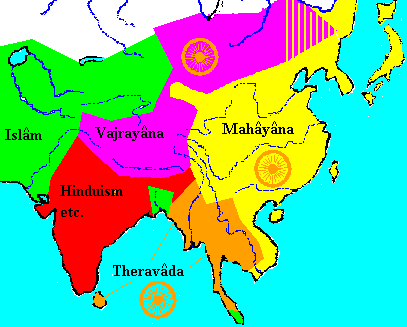1 – samma-ditthi (samyag-dristi) – in Advayavada: our very best comprehension or insight: right doctrine (Arnold), right view (Bahm, Bodhi, Ch’en, Gethin, Grimm, Guenther, Harvey, Horner, St Ruth, Takakusu, Watts), appropriate vision (Batchelor), right understanding (Burt, Dhammananda, Fernando, Humphreys, Keown, Kornfield, Narada, Nyanatiloka, Rahula, Saddhatissa, Stroup), right views (Conze, David-Neel, Dharmapala, Eliot, Malalasekera, Rhys Davids), right knowledge (Dharmapala, Khemo), right belief (Narasu); proper views (Edwardes); correct insight (Kloppenborg), correct faith (Scheepers)
2 – samma-sankappa (samyak-samkalpa) – in Advayavada: our very best resolution or determination: right purpose (Arnold, Burt, Horner), right resolve (Bahm, David-Neel, Keown), appropriate thought (Batchelor), right intentions (Bodhi, Conze), right intention (Ch’en, Gethin, Khemo, St Ruth), right thoughts (Dhammananda, Narada), right desires (Dharmapala), right aspirations (Dharmapala, Eliot, Malalasekera, Rhys Davids), right thought (Fernando, Rahula, Saddhatissa, Takakusu), right resolution (Grimm), right conception (Guenther), right directed thought (Harvey), right motives (Humphreys), right attitude (Kornfield), right attitude of mind (Stroup), right aspiration (Narasu), right mindedness (Nyanatiloka), right understanding (Watts); proper hopes (Edwardes); correct resolve (Kloppenborg), correct thinking (Scheepers)
3 – samma-vacha (samyag-vac) – in Advayavada: our very best enunciation or definition (as Karl Popper says, putting our ideas into words, or better, writing them down, makes an important difference, for in this way they become objective and criticizable): right discourse (Arnold), right speech (Bahm, Bodhi, Burt, Ch’en, Conze, David-Neel, Dhammananda, Dharmapala, Eliot, Fernando, Gethin, Guenther, Harvey, Horner, Humphreys, Keown, Khemo, Kornfield, Malalasekera, Narada, Narasu, Nyanatiloka, Rahula, Rhys Davids, Saddhatissa, St Ruth, Stroup, Takakusu, Watts), appropriate speech (Batchelor), right speaking (Grimm); proper language of definition (Edwardes); correct speech (Kloppenborg, Scheepers)
4 – samma-kammanta (samyak-karmanta) – in Advayavada: our very best disposition or attitude: right behaviour (Arnold), right conduct (Burt, Conze, Eliot, Malalasekera, Rhys Davids), right action (Bahm, Bodhi, Ch’en, David-Neel, Fernando, Gethin, Guenther, Harvey, Horner, Humphreys, Keown, Khemo, Kornfield, Narada, Narasu, Nyanatiloka, Rahula, Saddhatissa, St Ruth, Stroup, Takakusu, Watts), appropriate action (Batchelor), right actions (Dhammananda, Dharmapala), right acting (Grimm); proper behaviour (Edwardes); correct action (Kloppenborg, Scheepers)
5 – samma-ajiva (samyag-ajiva) – in Advayavada: our very best implementation, realization or putting into practice: right purity (Arnold), right vocation (Burt, Watts), right livelihood (Bahm, Bodhi, Ch’en, Conze, Dhammananda, Dharmapala, Eliot, Fernando, Gethin, Harvey, Horner, Keown, Khemo, Kornfield, Malalasekera, Narada, Rahula, Rhys Davids, Saddhatissa, St Ruth, Stroup, Takakusu), appropriate livelihood (Batchelor), right living (David-Neel, Narasu, Nyanatiloka), right mode of life (Grimm), right life (Guenther), right means of livelihood (Humphreys); proper way of earning one’s living (Edwardes); correct living (Kloppenborg), correct livelihood (Scheepers)
6 – samma-vayama (samyag-vyayana) – in Advayavada: our very best effort or commitment: right thought (Arnold), right effort (Bodhi, Burt, Ch’en, Conze, David-Neel, Dhammananda, Eliot, Fernando, Gethin, Grimm, Harvey, Humphreys, Keown, Khemo, Kornfield, Malalasekera, Narada, Narasu, Nyanatiloka, Rahula, Rhys Davids, Saddhatissa, St Ruth, Stroup), appropriate effort (Batchelor), right exertion (Dharmapala, Guenther), right endeavour (Bahm, Dharmapala, Horner, Takakusu), right application (Watts); proper effort in the proper direction (Edwardes); correct exertion (Kloppenborg), correct striving (Scheepers)
7 – samma-sati (samyak-smriti) – in Advayavada: our very best observation or reflection and self-correction: right loneliness (Arnold), right alertness (Burt), right mindfulness (Bahm, Bodhi, Ch’en, Conze, Dhammananda, Dharmapala, Eliot, Fernando, Gethin, Harvey, Horner, Keown, Malalasekera, Narada, Rahula, Rhys Davids, Saddhatissa, St Ruth, Takakusu), appropriate mindfulness (Batchelor), right attention (David-Neel), right recollectedness (Grimm, Watts), right inspection (Guenther), right recollection (Humphreys, Stroup), right attentiveness (Khemo, Nyanatiloka), right concentration (Kornfield), right thought (Narasu), right remembrance, right memory, right awareness; full understanding of action and thought (Edwardes); correct attention (Kloppenborg, Scheepers)
8 – samma-samadhi (samyak-samadhi) – in Advayavada: our very best meditation or concentration towards samadhi: right rapture (Arnold, Eliot, Malalasekera), right samadhi (Bahm, Dharmapala), right concentration (Bodhi, Burt, Ch’en, Conze, Dhammananda, Fernando, Gethin, Grimm, Guenther, Harvey, Horner, Khemo, Narada, Nyanatiloka, Rahula, Saddhatissa, St Ruth, Takakusu), appropriate concentration (Batchelor), right meditation (David-Neel, Humphreys, Keown, Stroup), right illumination (Dharmapala), right awareness (Kornfield), right tranquility (Narasu), right contemplation (Rhys Davids, Watts); absolute concentration of purpose (Edwardes); correct concentration (Kloppenborg, Scheepers)
samadhi (Skt.) total or perfect concentration (of the mind, cf. enstasy); non-dualistic state of consciousness in which the experiencing subject becomes one with the experienced object; total absortion in the object of meditation; transcendence of the relationship between mind and object; merging of subject and object; to contemplate the world without any perception of objects; suspension of judgement; turiyatita; satori; bodhi; rigpa; realization of the sameness of the part and the whole, of the identity of form and emptiness, of samsara and nirvana, of the immediate and the ultimate; mystic oneness; perfect dynamic attunement with wondrous overall existence; oceanic feeling; wonder, awe, rapture; essential purity; deep love and compassion; awareness of our common ground and the innocence of sex.


